www.cdc.gov/features/braininjury
- Damage to the brain may vary in extent, area and type of damage depending on a variety of factors relating to the nature of the injury, severity of the injury, how it occurred and how quickly medical attention was sought.
- Learn more about the structure and function of the brain with an interactive 3D brain
BACK TO TOP
How Can A Brain Injury Affect My Student’s Performance?
- In general, a student who has sustained a brain injury may show difficulties with processing information, concentrating, test taking and communication among other things.
- The Learnet problem solving process that is emphasized on this site, addresses the most common ways that students’ performance is affected by brain injury.
- As you work through the problems seen pages you will begin to see that the “problems” the student may be exhibiting, can be categorized into four groups:
I. General/Medical
II. Cognitive/Self Regulatory
III. Behavioral
IV. Social/Emotional
Begin the process by clicking on the most prominent problem that you have been able to clearly observe
→ Keep in Mind: a student with a brain injury often times has:
1. previous successful experiences in academic and social settings
2. a pre-morbid self concept of being “normal”
3. discrepancies in ability levels
4. inconsistent patterns of performance
5. more extreme problems with generalizing, integrating or structuring information
6. poor judgment and loss of emotional control which may make the student appear emotionally disturbed at times
BACK TO TOP
TBI Statistics
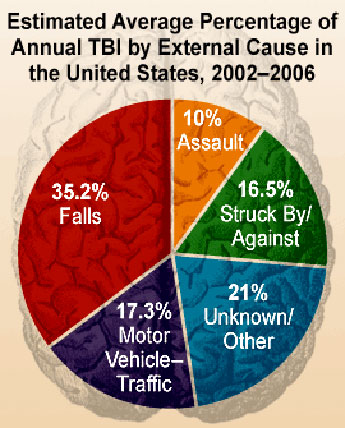 *1.7 million TBI related deaths, hospitalizations and emergency department visits annually in the U.S.
*1.7 million TBI related deaths, hospitalizations and emergency department visits annually in the U.S.
*TBI is a contributing factor in 1/3 of all injury related deaths in the U.S.
*Children aged 0-4, 15-19 and adults 65+ are most likely to sustain a TBI
*473,947 emergency department visits for TBI are made annually by children aged 0-14 years.
*Of Children , males 0-4 years have the highest rates of TBI related emergency department visits, hospitalizations and deaths combined.
More information about TBI statistics can be found by visiting: http://www.cdc.gov/Features/dsTBI_BrainInjury
BACK TO TOP
Resources Available to Educators
NYS FACTS Coordinators:
FACTS coordinators provide local resources, training, information, advocacy and emotional support. The FACTS program is a unique New York statewide program offered at no charge for individuals who have sustained a brain injury prior to age 22, and their families.
http://www.projectlearnet.org/contact_us.html
 This publication serves as an introduction for educators to the needs of students struggling in school, addresses the unique differences between TBI and other disabilities and provides ideas for classroom accommodations that target cognitive and behavioral challenges.
This publication serves as an introduction for educators to the needs of students struggling in school, addresses the unique differences between TBI and other disabilities and provides ideas for classroom accommodations that target cognitive and behavioral challenges.
 TBI Education: Offers evidence based information and resources for educators. Learn more about school reentry, teaching strategies and more.
TBI Education: Offers evidence based information and resources for educators. Learn more about school reentry, teaching strategies and more.
 Colorado's Department of Education-
Colorado's Department of Education-
TBI: A Manual for Educators
 Fact sheet created by the Brain Injury Association of NYS
Fact sheet created by the Brain Injury Association of NYS
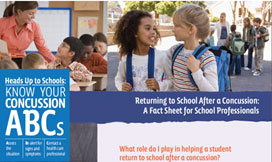 Returning to School After a Concussion: A Fact Sheet for School Professionals
Returning to School After a Concussion: A Fact Sheet for School Professionals
A part of the "Heads Up" series created by the Centers for Disease Control-National Center for Injury Prevention and Control
 Heads Up to Schools Fact Sheet
Heads Up to Schools Fact Sheet
A part of the "Heads Up" series created by the Centers for Disease Control-National Center for Injury Prevention and Control
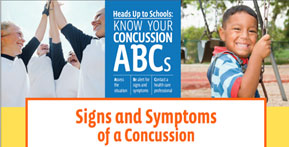 CDC-Concussion Signs and Symptoms Laminated Card
CDC-Concussion Signs and Symptoms Laminated Card
A part of the "Heads Up" series created by the Centers for Disease Control-National Center for Injury Prevention
and Control
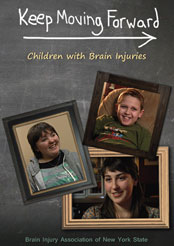 Keep Moving Forward: Children with Brain Injuries
Keep Moving Forward: Children with Brain Injuries
This documentary provides a moving account of the lives of three families with children who sustained brain injuries. The film focuses on changes in family dynamics, school-related issues, and the possibilities of lifelong recovery.
Created by the Brain Injury Association of NYS
 This site is designed to provide educators and professionals with practical information that can be used to identify and provide appropriate services to children with a brain injury. Information provided includes a TBI identification protocol, manual, matrix, concussion information and additional resources.
This site is designed to provide educators and professionals with practical information that can be used to identify and provide appropriate services to children with a brain injury. Information provided includes a TBI identification protocol, manual, matrix, concussion information and additional resources.
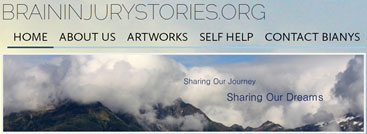 Brain Injury Stories:
Brain Injury Stories:
A blog by the Brain Injury Association of NYS
• New Jersey Brain Injury Alliance: Guide for Educators http://www.tndisability.org/system/files/
u1/GuideforEducators2008.pdf
• Helpful Handouts: Handouts created by the Brain Injury Association of NYS that explain neuropsychological assessment and various intervention strategies for individuals with TBI.
Collaborative Problem Solving
 Lives in the Balance is a non-profit organization founded by child psychologist, Dr. Ross Greene, author of The Explosive Child and Lost at School and the originator of the Collaborative Problem Solving approach. The approach serves as a model for understanding and helping kids with social, emotional, and behavioral challenges.
Lives in the Balance is a non-profit organization founded by child psychologist, Dr. Ross Greene, author of The Explosive Child and Lost at School and the originator of the Collaborative Problem Solving approach. The approach serves as a model for understanding and helping kids with social, emotional, and behavioral challenges.
In addition to Lives in the Balance, Dr. Ross Greene maintains two other websites: www.cpsconnection.com for advanced training and certification for proficiency in CPS and www.cpsinitiative.com offering a complete package of information needed to implement CPS.
o Voices of Collaborative Problem Solving…
o Hear the stories of fellow teachers and school professionals around the country as they describe CPS and how it has helped them with some of their most challenging students.
http://www.livesinthebalance.org/
voices-of-collaborative-problem-solving
We are pleased to connect our users with another wonderful resource! We hope you find it useful.